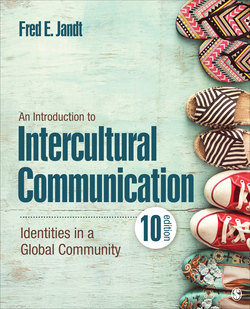Читать книгу An Introduction to Intercultural Communication - Fred E. Jandt - Страница 73
На сайте Литреса книга снята с продажи.
Third Culture
ОглавлениеJohn Useem, John Donahue, and Ruth Useem (1963) introduced the concept of binational third culture. Casmir and Asuncion-Lande (1989) refined the concept Third culture to refer to a new culture that two or more individuals from different cultures can share that is not merely the fusion of the separate cultures but a new coherent whole. One example is international marriage (also referred to as transnational marriage).
Five percent of marriages in Japan in 2008–2009 included a foreign spouse (with four times as many foreign wives as husbands). In South Korea, over 10% of marriages included a foreigner in 2010. In Taiwan, 13% of wives were foreigners in 2009. (Chinese citizens are not considered foreigners in Taiwan.) In France, the percentage of international marriage rose from about 10% in 1996 to 16% in 2009. In Germany, the rise was from roughly 11% in 1990 to 14% in 2010. Approximately one in five marriages in Sweden, Belgium, and Austria is with a foreign partner (“International Marriage,” 2011).
The wedding of Prince Harry and U.S.-born Meghan Markle had elements of both cultures with a gospel choir and U.S. Episcopalian bishop Michael Curry who references African-American spirituals and Black enslavement.
Jane Barlow/PA Images/Getty Images
Intercultural marriages face many barriers including language, differences in religion and values, gender roles, child rearing, and relations with families and friends. Tili and Barker (2015) studied marriages of Asian and Caucasian U.S. spouses. Their study identified the intercultural communication competencies in international marriages:
Self-awareness and other-awareness: the ability to delineate cultural differences and similarities between themselves and their spouses
Open-mindedness: being open to change in order to reconcile cultural differences
Mindfulness: being aware of and sensitive to cultural differences rather than making assumptions about similarities
Self-disclosure: meeting your spouse’s needs for verbalizing emotions
Face support: adapted to Asian spouse’s need for certain customs (You’ll read more about this concept in the next chapter.)
Think of a marriage between an individual raised in China and an individual raised in the United States. It might make a difference where the couple is living—China, the United States, or some other culture. In the relationship, one individual could attempt to adopt the culture of the other, or both individuals could attempt to build a new culture beyond their original cultures. Using the rhetorical sensitivity theory, the individual who adopts the culture of the other may be a rhetorical reflector initially, but then probably uses that to build rhetorical sensitivity as the relationship continues to develop. The individuals who attempt to build a new culture may be rhetorical sensitives. Rhetorical sensitivity may be critical for intercultural marriages.
Some studies have concluded that intercultural marriages are difficult to establish and maintain; others have concluded that there is no evidence that they fail more often than intracultural ones (Tili & Barker, 2015).
Another use of the term third culture has been to refer to children in expatriate families who reside outside of their home culture for years at a time (R. Useem & Downie, 1976). Other terms that have been used are global nomads, transnationals, and internationally mobile children (Gerner, Perry, Moselle, & Archbold, 1992). Ruth Useem (1999) argues that these people integrate elements of their home culture and their various cultures of residence into a third, different and distinct culture and may experience cultural marginality because of no longer feeling comfortable in any specific culture. In some ways, President Barack Obama is a third-culture kid. He was born in Honolulu to a mother from the United States and a father from Kenya. When Obama was 2 years old, his father returned to Kenya. His mother remarried and moved to her new husband’s homeland, Indonesia. Obama attended public school in Indonesia until he was 10 and then returned to Honolulu to live with his maternal grandparents. New York Times columnist David Brooks (2008) described Obama as a “sojourner who lives apart” (p. A33).
While most research has been with children from the United States, studies have shown that third-culture kids have a high level of interest in travel and learning languages and feel accepting of cultures and diversity (Gerner et al., 1992). Iwama (1990) found third-culture kids to be more self-confident, flexible, active, and curious and to have greater bilingual ability.
Does biculturalism as represented by third-culture kids represent a way to transcend nationalism and ethnocentrism and a way to create diverse communities (D. B. Willis, 1994)? There are suggestions of difficulties: Third-culture kids may have difficulty in maintaining relationships and in direct problem solving (C. A. Smith, 1991).
